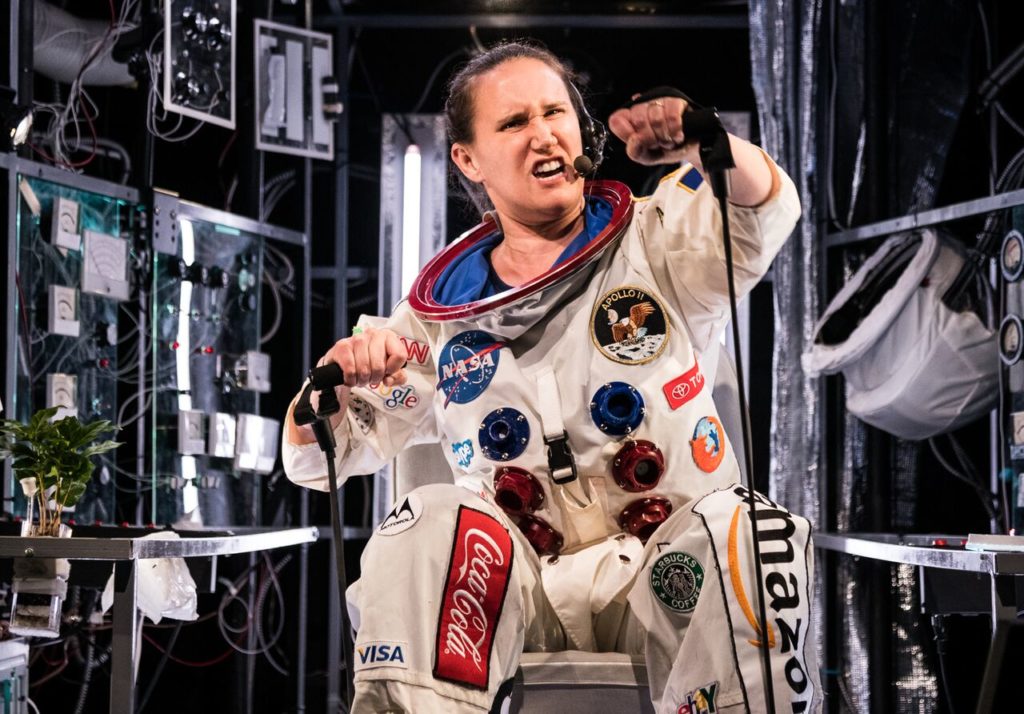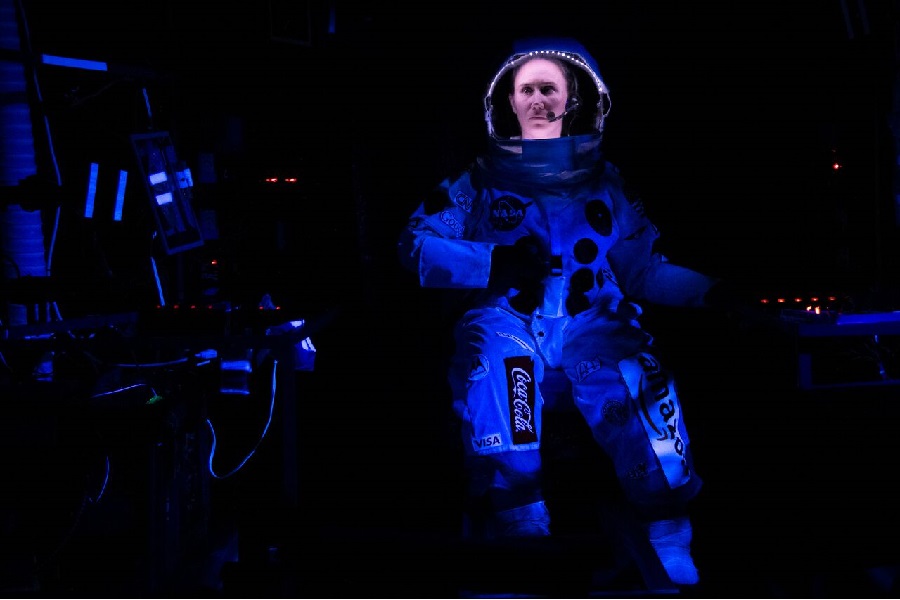This time last year, Erin Treadway and Leegrid Stevens were in an Uber on their way to a clinic where they would learn that Treadway had broken both of her arms and one of her wrists. The injuries were sustained in an accident during the opening night curtain call of Spaceman, a solo show about an astronaut on an exploratory mission to Mars, written by Stevens and performed by Treadway. The show did not go on, and Spaceman—slated to run last February at the Wild Project in the East Village—was grounded until further notice.
“Coming back has been great,” Treadway said last week as she prepared to return to the role and the show, set to open Feb. 14, in a production by Loading Dock Theatre. Not that the transition over the past year has been easy: Treadway couldn’t even bear weight on her arms for the first few months of recovery. Since starting rehearsals for the new production, she has been working on enhancing her movements for the show, which involves simulated weightlessness (hence the danger of injury). She began the process by watching videos of NASA astronauts, whose gravity-free movements she compared to moving through water. Recreating this outer-space condition requires a great deal of concentration: In addition to being conscious of how she reaches for objects and remembering little tricks, such as keeping her hips low, Treadway navigates an elevated set that features a metal grid instead of a floor.
While Treadway’s accident delayed Spaceman’s run, it also provides an interesting parallel to the events of Stevens’s play, in which an injury leads to a reassessment of everyday life. Following the real-life accident, Treadway had to determine alternative solutions to seemingly simple tasks such as brushing her teeth or pouring a bowl of cereal—a reassessment surprisingly similar to the experiences of Molly Jennis, the character at the center of Spaceman, who must learn to adapt to life in space. In both instances, Stevens pointed out, there is a need to “redefine how to exist physically,” though Treadway’s circumstances were on a smaller scale than Jennis’s.
Treadway draws further comparison between the plot of Spaceman and the production itself: In both cases, though we only see one person—an actor onstage or an astronaut in orbit—there is an entire team working with that individual who is equally invested in the success of the project. “This has been the most collaborative project I have worked on,” she said.

Not least among Spaceman’s team is Stevens, who serves on the upcoming production not only as playwright but also as sound designer. The origins of Spaceman lay partly in noise, not the phenomenon but the experimental music genre; one song he heard sounded like a “spaceship crashing through the atmosphere,” said Stevens. Sound was thus a major contributor to the development of the text, which proved to have its own benefits and challenges. As a plus, Stevens was able to use sound to inform the script in instances such as aligning a shift in sound with a major change in the story. But while this can create a thoughtful relationship between the visual and the aural, the downside is that it’s harder to make changes to the piece during rehearsals, as any alterations of the text additionally required modifications of the sound design. The inclusion of noise music was not solely a theatrical decision, however; Treadway mentions that astronauts often complain that the amount of sound they hear on missions prevents them from being able to sleep.
In addition to noise, Stevens cites two other primary inspirations: Fiona Shaw’s performance in a 2008 production of Samuel Beckett’s Happy Days, in which a woman performs a largely uninterrupted monologue while buried up to her waist, and the hypothetical question of sending an individual to Mars. Stevens was particularly interested in exploring the bare minimum of what it would take to keep a person alive in a confined space, and in the case of a solo trip to Mars, there was additional themes of isolation and worldwide fame.
The loneliness of orbit is indeed simulated in Spaceman, as Treadway is the only actor on stage. She is joined, however, by a puppeteer (Shawn Davis in the upcoming production), who operates the multiple floating objects Treadway interacts with throughout the show. Stevens considers the use of puppetry in the production to be a “happy accident” springing from earlier decisions; when set designer Carolyn Mraz proposed lifting the entire set three feet above the stage, he said, the empty space beneath provided enough room for a puppeteer to navigate the “floating” props through the grid-like bottom of the set. This innovation is especially important when considering that these items provide the only source of interaction for Treadway, who noted that in absence of multiple characters, “The objects become the other characters.”
Treadway and Stevens both hope that Spaceman might tour, and, if budget ever allows, explore technologies such as turntables and harnesses to further the effect of simulated weightlessness. When asked if they would want to stage a production for NASA employees, Treadway answered, “So frightening—but yes.”
As for the more distant future, neither Treadway or Stevens said they would accept a one-way ticket to Mars—“I get motion sickness traveling in a car,” Treadway joked. For his part Stevens said he loves exploring the possibilities of space travel through theatre, but is content doing so on Earth.
And Treadway’s curtain call this time around? “It will be completely choreographed,” Stevens said with a laugh. “She’ll crowd surf.”


